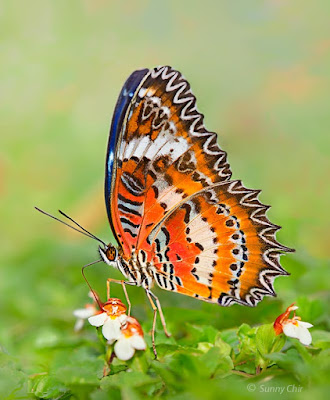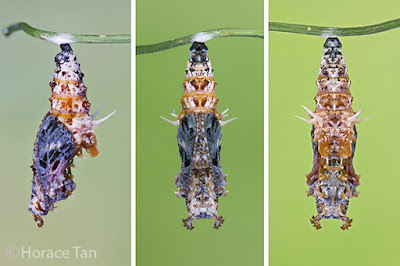Butterfly Biodata:
Genus: Cethosia Fabricius, 1807
Species: methypsea Butler, 1879
Sub-species: methypsea Butler, 1879
Wingspan of Adult Butterfly: 60-80mm
Caterpillar Local Host Plant: Adenia cordifolia (Passifloraceae).
Physical Description of Adult Butterfly:
On the upperside, the forewing is black with a white subapical band (broader in the female than in the male) beyond the cell; the basal area is rich orange-red for the male and reddish brown for the female. The hindwing has a black border but is mainly rich orange-red in the male and reddish brown in the female, and there is a series of black spots embedded in the distal margin of the orange-red/reddish-brown area. On the underside, the wings are orange-red (with reddish areas confined to the basal half) with white fasciae adorned with black spots. The forewing cell has several black-edged, pale blue transverse stripes. The wing borders are dark brown and deeply indented with lace-like pattern of white markings. The hindwing has a narrow white submarginal band in addition to the broad, white postdiscal band, both of which are bordered with a series of black spots.
Field Observations of Butterfly Behaviour:
The Plain Lacewing is rarely seen in Singapore and its local occurrence is confined to a small patch of forest in the catchment reserve. Adults have been sighted visiting flowers of flowering plants in forest clearings or alongside forest trails. At times, females can also be seen checking out leaves of its host plant in search of an ovipositing site.
Early Stages:
The local host plant is a vine in the Passifloraceae family and its exact species ID is yet to be determined. It has the distinctive feature of having a variety of leaf shapes and has tendrils which terminate in adhesive pads. Caterpillars of the Plain Lacewing feed on leaves, petiole and stems of the host plant. The Plain Lacewing caterpillars are gregarious throughout all five instars, often eating, resting and moulting together in groups.
Local host plant of the Plain Lacewing, Adenia cordifolia showing the trilobate leaf form.
The eggs of the Plain Lacewing are laid in a moderately large cluster (in teens) on a leaf (underside), a petiole, a young stem or even a tendril. Each egg is pale yellow, barrel-shapped with a ribbed surface. Height: ~1.3mm, diameter of cross section: ~1mm.
A female Plain Lacewing laying eggs on the underside of a leaf.
A cluster of eggs of the Plain Lacewing laid on the petiole of a leaf of the host plant.
A cluster of eggs of the Plain Lacewing laid on the underside of a leaf of the host plant.
Each egg takes about 5-6 days to mature. The young caterpillar nibble away sufficiently large portion of the egg shell to emerge, and typically makes little effort to eat the remnant of the egg shell. The newly hatched has a cylindrical body in yellowish brown, and an initial body length of about 3mm. The body is covered in a grid of tubercles, each with a single long seta. The head is black and there is a pair of short black spines on the first thoracic segment. When feeding, the young caterpillar either skims the lamina on a young leaf or nibbles away at the surface of a young stem.
Two views of a mature egg of the Plain Lacewing.
Two views of a newly hatched caterpillar, length: 3mm.
Two views of a 1st instar caterpillar, late in this stage, length: 4mm.
As the 1st instar caterpillar grows, the body color darkens to orange and finally to wine-red. A faint white saddle mark appears on the 4th abdominal segment initially, but turns prominently white when the caterpillar lies dormant to moult. After 2-2.5 days in the 1st instar and reaching a length of about 5-6mm, the caterpillar moults to the next instar.
A group of 1st instar caterpillars, dormant prior to their moult.
The 2nd instar caterpillar has a dark wine-red body colour, and the rows of tubercles in the 1st instar are replaced by 6 longitudinal rows of dark fine-pointed spines, 3 to each side of the body. The spines in uppermost two rows are the longest. A pair of short and black coronal spine appears on the head. The white saddle is prominently marked. This instar lasts about 2-2.5 days with the body length reaching about 8-9mm before the next moult.
Two views of a group of 2nd instar caterpillars found in a nature reserve.
Two views of a 2nd instar caterpillar, length: 8mm.
The 3rd instar does not bring along any drastic change in physical appearance except for proportionately longer coronal spines (now about the same length as the height of the head capsule), and the larger and more distinct white saddle mark. This instar takes 2-3 days to complete with body length reaching about 15-16mm.
Two views of a 3rd instar caterpillar, early in this stage, length: 10mm.
A group of 3rd instar caterpillars on the underside of a leaf of the host plant.
Two views of a 3rd instar caterpillar, late in this stage, length: 15.5mm.
The coronal spines in the 4th instar caterpillar are again longer proportionately with the length of each spine about equal to the 1.5x height of the head capsule. The spines in the white body segment are now coloured entirely white except for their pointed tips. The upper half of the body is bright scarlet red (especially on the dorsum of 2nd-3rd thoracic segments and 1st, 2nd, 7th-9th abdominal segments), while the lower half is dark wine red. The 4th instar lasts about 2-2.5 days with body length reaching about 22-23mm.
Two views of a newly moulted 4th instar caterpillar.
A group of 4th instar caterpillars almost done with a leaf of the host plant, length: 15mm.
Two views of a 4th instar caterpillar, length: 23mm.
The next moult brings the caterpillar to its 5th and final instar. The caterpillar retains the same body features as in the 4th instar. Now the coronal spines are about 2x the height of the head capsule, and the bright scarlet red dorsal patches appear on almost all body segments. This instar lasts for 3-4 days with the body length reaching up to 32-34mm.
Two views of a newly moulted 5th instar caterpillar, length: 24mm.
A group of early 5th instar caterpillars, nibbling at the tip of a stem.
Two views of a 5th instar caterpillar, length: 32mm.
Toward the end of 5th instar, the caterpillar stops feeding and moves around in search of a pupation site. Finally the caterpillar finds a spot on the underside of a leaf, stalk or stem to spin a silk pad to which it secures itself with the claspers at its posterior end. Now the caterpillar is an immobile pre-pupa, hanging vertically from this pupation site. At times, several pre-pupae could be found in close proximity.
Three pre-pupatory larvae of the Plain Lacewing found on the underside of a leaf.
A group of 3 fresh pupae and a pre-pupa of the Plain Lacewing, on the underside of a leaf.
A Plain Lacewing caterpillar moults to its pupal stage.
Pupation takes place a day later. The pupa hangs vertically. It has two pairs of slender pointed white processes at the middle of its body and a number of less prominent dorsolateral processes. A pair of foliaceous processes adorn the head. Body color is pale brown mottled with white and black patches, and several dorsal spots of silvery/gold colour. Length of pupae: 28-30mm.
Three views of a pupa of the Plain Lacewing. Left: lateral view; Middle: ventral view; Right: dorsal view.
After about 6 days of development, the pupa becomes darkened. The next day the adult butterfly emerges to kick-start the around round of the life cycles for this species.
Three views of a mature pupa of the Plain Lacewing.
A Plain Lacewing emerges from its pupal case.
Newly eclosed Plain Lacewing clinging on to its pupal case.
References:
- [C&P4] The Butterflies of The Plain Peninsula, A.S. Corbet and H.M. Pendlebury, 4th Edition, Malaysian Nature Society.
- Butterflies of Thailand, Pisuth Ek-Amnuay, 2nd Edition, 2012
- A Field Guide to the Butterflies of Singapore, Khew S.K., Ink On Paper Communications, 2010.


































4 comments:
Hi Horace, did you notice any consistent difference(s) between these larvae and those of Cethosia hypsea (Malay Lacewing)? Thanks!
Hi Keith, yes, I did. The consistent difference is in the red dorsal patches on the 2nd-3rd thoracic and the 1st abdominal segment. You can refer to this BC forum post for the comparison pics.
Thank you again, Horace – fyi . . .
https://www.flickr.com/photos/rainforests/10071085905/
Thanks, Keith for sharing that interesting find in Sumatra. :)
Hopefully the caterpillars or the lacewing colonies have not been adversely affected by the serious fire/haze ongoing there.
Post a Comment